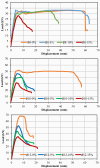Bending Performance of Reinforced Concrete Beams with Rubber as Form of Fiber from Waste Tires
- PMID: 39459663
- PMCID: PMC11509843
- DOI: 10.3390/ma17204958
Bending Performance of Reinforced Concrete Beams with Rubber as Form of Fiber from Waste Tires
Abstract
An investigation was conducted to assess the efficacy of using waste rubber as a substitute for a portion of an aggregate to enhance concrete's sustainability. For the purpose of accomplishing this objective, a total of 12 specimens were constructed and then subjected to a series of tests to investigate their bending behavior. The samples were constructed with the following dimensions: 1000 mm length and a 100 mm by 150 mm cross-sectional area. A few factors were selected, including the impacts of the longitudinal reinforcement ratio and the waste rubber ratio. Based on the volume of aggregates, rubber replacement rates of 0%, 5%, 10%, and 15% were investigated in this study. To assess the beam bending behavior, the stirrup width and spacing were kept constant at ∅6/10. The longitudinal reinforcement was composed of three diameters: ∅6 at the top (for all beams) and ∅8, ∅10, and ∅12 at the bottom. The experimental results demonstrated that the effects of varying amounts of waste rubber and tension reinforcement on the bending and cracking of reinforced concrete beams (RCBs) were varied. The findings indicate that the incorporation of waste rubber into concrete results in a reduction in both the load-carrying capacity and the level of deformation of the material. Additionally, it was shown that as the amount of waste rubber in the RCB increased, the energy absorption capacity and ultimate load decreased. There was a reduction in energy dissipation of 53.71%, 51.69%, and 40.55% for ∅8 when longitudinal reinforcement was applied at 5%, 10%, and 15% replacement, respectively. Additionally, there were reductions of 25.35%, 9.31%, and 58.15% for ∅10, and 38.69%, 57.79%, and 62.44% for ∅12, respectively.
Keywords: beam; recycled; reinforced concrete; rubber; waste.
Conflict of interest statement
The authors declare no conflicts of interest.
Figures










References
-
- Azunna S.U., Aziz F.N., Rashid R.S., Bakar N.B. Review on the characteristic properties of crumb rubber concrete. Clean. Mater. 2024;12:100237. doi: 10.1016/j.clema.2024.100237. - DOI
-
- Yıldızel S.A., Özkılıç Y.O., Bahrami A., Aksoylu C., Başaran B., Hakamy A., Arslan M.H. Experimental investigation and analytical prediction of flexural behaviour of reinforced concrete beams with steel fibres extracted from waste tyres. Case Stud. Constr. Mater. 2023;19:e02227. doi: 10.1016/j.cscm.2023.e02227. - DOI
-
- MSV Mediaservice & Verlag GmbH. 2024. [(accessed on 28 September 2024)]. Available online: https://global-recycling.info/
-
- Xiong Z., Li H., Pan Z., Li X., Lu L., He M., Li H., Liu F., Feng P., Li L. Fracture properties and mechanisms of steel fiber and glass fiber reinforced rubberized concrete. J. Build. Eng. 2024;86:108866. doi: 10.1016/j.jobe.2024.108866. - DOI
Grants and funding
LinkOut - more resources
Full Text Sources

